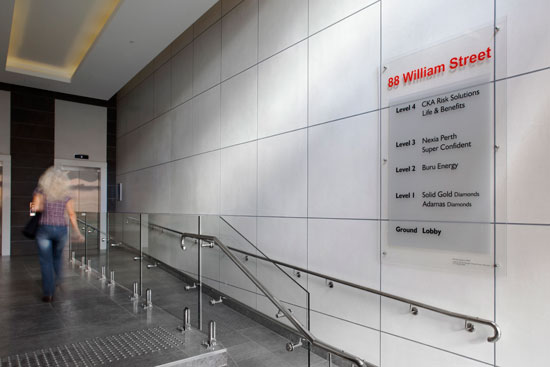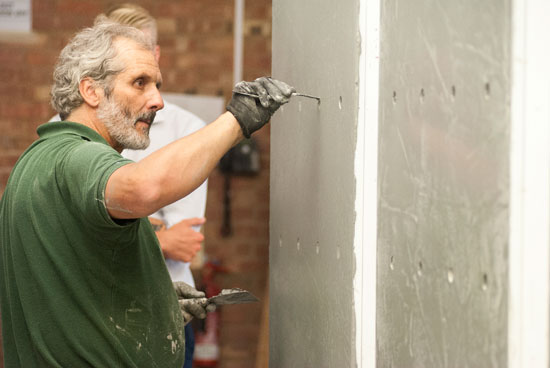Pre-Finished Modular Plaster Panels
Common Plaster Materials
Plaster is a manufactured product made from lime and different cementitious or stone-based materials depending on the type. It is mixed into a paste or putty by slaking it with water which causes a reaction generating heat through crystallization. In this state it can be worked fairly easily using metal trowels, tools or molds. Ultimately, the hydrated and formed plaster hardens into a strong, durable finish.
The term plaster can refer to several common types including lime plaster, cement plaster, gypsum plaster (also known as Plaster of Paris) and polished style plaster.
Lime plaster:
To make lime plaster, limestone (calcium carbonate) is heated to produce quicklime (calcium oxide) which is then mixed with sand (or other inert fillers). Water is added to the mix to produce slaked lime (calcium hydroxide). Prior to use, additional water is added to form a workable paste. When exposed to carbon dioxide in the atmosphere, the calcium hydroxide very slowly turns back into calcium carbonate, causing the plaster to increase in strength. Whitewash is based on the same chemistry. The plaster used in most lath and plaster construction was mainly lime plaster, with a cure time of about a month.
Gypsum plaster:
An alternative to lime-based plasters is the use of gypsum-based plasters that have a faster curing time. This newer form of plaster grew in popularity primarily because it could speed up the building process. To stabilize lime plaster during curing, small amounts of gypsum plaster (Plaster of Paris) were incorporated into the mix. Because it sets quickly, "retardants" were actually used to slow setting time enough to allow workers to mix large working quantities of lime plaster putty. Today gypsum plaster is used to manufacture gypsum board or “drywall”—so named because it eliminates the need for water on site to mix the plaster. A primary advantage of gypsum and lime plaster is that it is resistant to fire helping to meet building code requirements, reduce potential damage and help protect occupants.
Cement plaster:
Cement plaster is a mixture of suitable plaster, sand, portland cement and water. Instead of covering lath, it is normally applied over masonry on the interior or exterior of a building to achieve a smooth, finished surface. Interior surfaces may sometimes receive a final layer of gypsum plaster for a preferred appearance. Normally, plaster covers less expensive stock bricks while face brick walls are not plastered. Various cement-based plasters are also used as proprietary spray fireproofing products that may use vermiculite as lightweight aggregate. Cement plaster was first introduced in America around 1909 and was often called by the generic name adamant plaster after a prominent manufacturer of the time. The advantages of cement plaster include its strength, hardness, quick setting time and durability.

Photo courtesy of ArmourFX, a division of Armourcoat Surface Finishes, Inc.
Polished plaster can be made from lime and marble powder producing a finished appearance like stone.
Polished plaster:
Polished style plaster combines lime plaster with marble dust or powder to create a natural stone look. The term polished plaster actually refers to a whole range of decorative plaster finishes—from very highly polished stone to the rugged look of textured stone. Polished plaster is mainly used on interior walls and ceilings to produce a finish that looks like marble, travertine or limestone. Such plasters are usually applied over a primer and basecoat base in thin, multiple (from 1 to 4) layers. They are then finished (burnished) with a specialized steel trowel often to a smooth glass-like sheen giving it the illusion of depth and texture. Polished plaster is also usually sealed with a protective layer of wax. When left un-burnished, polished plaster has a matte finish that is rough and stone-like to the touch which is less durable and can be damaged rather easily. However, when applied correctly, polished plaster can be used to create a rock-hard, marble-like finish. This makes it especially useful on surfaces where marble panels could not be installed easily, and on surfaces that would be too expensive to have carved from real marble such as columns, corbels and curved walls. Polished plaster can be tinted, or colored using natural or synthetic colorants, making it particularly desirable when a specific marble color is being sought or when a color that does not exist naturally is wanted.
Marmorino is a type of polished plaster commonly used as decoration on walls. It was used as far back as Roman times, but was made popular during the Renaissance in Venice. It is made from crushed marble and lime putty, which can be tinted with ground terra cotta or other materials to produce a wide range of colors. It can be used to create various textures, from polished marble to coarser natural stone effects. Widely used in Italy, its appeal has spread through North America and even worldwide due to its use by contemporary architects. Because of the hours of workmanship required, however, its pricing often places it in high-end applications, although it is less expensive than cut stone. Nonetheless, many examples can be seen in public buildings, bars, restaurants, etc. Its water-resistant and bacteria-resistant qualities combined with good visual effects have also made it very desirable for luxury bathrooms and other wet areas.
Modern Modular Plaster Panels
The history and quality of plaster as a finish material has generated a renewed interest in using it for more building interior designs. However it can be challenging to find local skilled labor who can work with ‘wet’ plastering on site. Fortunately, overcoming this need for skilled labor and eliminating a wet process from the on-site work has been successfully addressed and solved through the use of custom fabricated, modular, plaster panels.

Photo courtesy of ArmourFX, a division of Armourcoat Surface Finishes, Inc.
Modular plaster panels are fabricated in a central location using skilled craftsmen avoiding the need to find local plasterers.
Plaster Panel Fabrication
The use of offsite construction in general is a growing trend that is fast becoming the construction method of choice for both contractors and their clients seeking to meet shorter time schedules, reduce delays and control cost. Modular plaster panel systems fit with this approach quite well since they can be skillfully fabricated to suit a project design, be sent directly to site, and then be readily installed by a local joiner or millworker. This is true whether they are part of a multiple panel array covering large wall areas or are part of a focused statement using single artwork or 3D display pieces.
Modular plaster panels are actually a composite product that uses a wide range of polished plaster finishes applied to a substrate panel. Common substrates are moisture-resistant or fire-rated medium density fiberboard (MDF) or plywood. The solid nature of these types of board stocks assures that a flat, precisely sized panel can be produced. Polished plaster finishes are applied over the substrate and crafted by hand in a climate-controlled setting to assure proper working and curing conditions. The polished plasters are either made from aged lime plaster or pre-hydrated lime plaster with other minor additives used to control working characteristics. Since each panel is custom made, the polished plaster panels are available in a huge range of textures and finishes.
The modular panels aren’t limited to flat finished surfaces. In the tradition of plaster building details, moldings, and art pieces, sculptural and three-dimensional panels can also be made. Gypsum plaster may be used in a mold to achieve quick setting pieces that can have stunning 3D surface textures and effects. Sculptural pre-cast panels are often created by combining computer-aided design with traditional hand sculpting to produce precise designs that still retain the essence of being hand crafted. Design options range from natural flowing patterns to more abstract designs or even corporate logos. When cured, these panels can be finished with standard paint or enhanced with the use of polished plaster or architectural coatings. This type of molded or cast plaster can also be used to create pieces that look and feel like stone. The material and manufacture process are ideally suited to creating shapes and designs that might otherwise be too complex for a hand applied finish of polished plaster.









